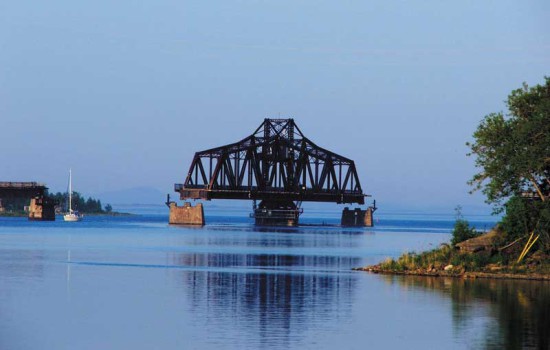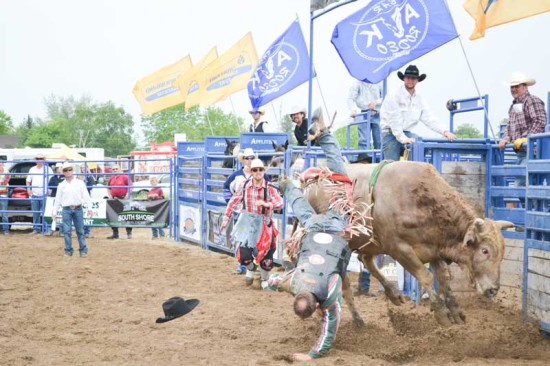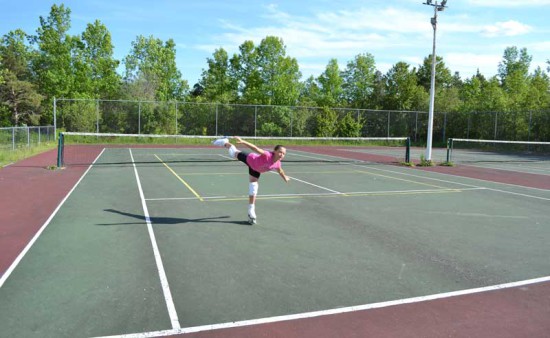A series of interviews with a veteran bridge tender
EDITOR’S NOTE: The official celebration of the Manitoulin Swing Bridge’s centennial is only three weeks away, July 12 to 14, and Little Current historian Alexander (Sandy) McGillivray completed an extensive interview with Dan Larouche, long-time CPR employee who started to work on the Swing Bridge in 1952. This interview was conducted on December 4, 2012.
Q: Dan, you have had connections with the swing bridge for a long time.
A: My father worked on the bridge in the mid ‘30s and became bridge tender again in 1943 and he was there until 1945. He took over a construction crew to effect the change over to highway use. I started to work on the swing bridge in 1952. I worked there for a little over 19 years. We called them bridge operators but actually the name is bridge tender. There were five operators all told. One was a maintenance person and operator as well. We worked eight-hour shifts, 24 hours a day.
Q: Who were some of the workers?
A: When I started, there was Wilbert Eade, Austin Bateman, Joe King and Claire “Dutch” Ramesbottom.
Q: What all was involved on the job?
A: Well, we had to keep track of the number of autos, trains, logging and boats. Those were all in a logbook––the time and name. That’s how they were recorded. We swung the bridge on demand for boats that gave the proper signal.
Q: Did you connect with them by radio?
A: No––with whistles. The bridge had a strong air horn to respond to the ships that blew for the bridge. The maintenance man kept a time book. He was operator for one shift a week and for the rest was maintenance man and kept track. The operator was in charge of the bridge.
Q: Dan, you said there was a pegboard.
A: For counting cars-it was easier. We didn’t have any “clicking” hand held counters and we just had a pegboard with rows of 10 holes and we’d count up to 100. There were 11 rows. The 11th would count hundreds.
Q: What did you have for communications?
A: We had telephones-a regular wired Bell telephone using a submarine cable. The bridge didn’t have electricity until 1945.
Q: At the museum there are a couple of lanterns from the bridge––red and green on either side.
A: As the bridge turned you’d see a different colour.
Q: Were they lit up by kerosene?
A: No. They were electric after ‘45.
Q: Before that?
A: Kerosene but with no colours. There were five. Two on each of the concrete piers and one on top of the bridge itself––the highest point.
Q: I suppose it would be your job to light them?
A: No, not me. That was before my time––before it was converted to highway use. But I did light them when I was a kid––helping my Dad do those things and it was fun doing it.
Q: You’d have to walk away out to the end of the piers?
A: There were steps down on the approaches and you would walk to the end of the piers.
Q: You probably weren’t involved with it, but the old original engine––a Fairbanks Morse single cylinder. Could you comment on how it worked?
A: Well, the first spark was from a wooden match about an inch long and it was installed in a bolt that was actually a spring anvil that was bolted into the head of the cylinder chamber. Compression would be built up by a big fly wheel and there was a priming cup as well. When enough compression was built up by the flywheel, the match was lit by hitting the assembly with the palm of your hand.
Q: That’s amazing.
A: The priming cup would put some gas into the combustion chamber.
Q: It sounds so primitive. What would be the diameter of the Fairbanks Morse piston?
A: It was at least 10” to 12” I assume. The flywheel, if I remember correctly, was probably a good five feet.
Q: That’s some kind of flywheel.
A: Yes. You turned the flywheel by hand and you built up enough pressure and that’s when you gave it ignition with the match.
Q: Could you use your foot to give it a turn?
A: You might if you put your weight on a spoke. It was dangerous if it backfired.
Q: The piston was 10” or more in diameter. Do you know what the stroke was?
A: I don’t know what the stroke was. It was a horizontal cylinder.
Q: After 1945 it was removed.
A: Yes, in 1945––no idea what the CPR did with it.
Q: Too bad it isn’t at our museum.
A: It would have been nice. With changes in industry and business…they didn’t take into consideration heritage…posterity.
Q: After the old Fairbanks Morse was removed, what came next?
A: Then they installed two six cylinder industrial Chrysler engines side by side taking approximately the same space as the original engine.
Q: The original engine was really big.
A: Oh yes. It took up a good piece of space. Only one engine was required to swing the bridge. The other one was back up or stand-by.
Q: I take it that they were battery started?
A: The same kind of starter that was in old cars with a starter switch on the floor of the car. We had a rod connecting that to the tender’s position where he operated the engine itself.
Q: About 8 or 10 years ago in The Manitoulin Expositor there was a picture of men swinging the bridge manually using rods connected to a capstan.
A: That’s right.
Q: The first swing of the bridge in 1913 was done that way since the engine had not yet arrived.
A: The capstan is under the operator’s room in the centre of the bridge and it had four long iron handles that were maybe 6’ to 7 ‘ long and you could have two men on each one and you could turn it that way.
Q: I bet it took a long time to turn it by hand.
A: It took a long time-moved very slowly.
by Alexander (Sandy) McGillivray
NEXT WEEK: More of Dan Larouche’s reminiscences about the Manitoulin Swing Bridge’s eccentricities as conveyed to Sandy McGillivray during interviews.





